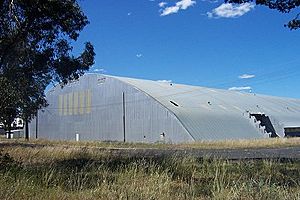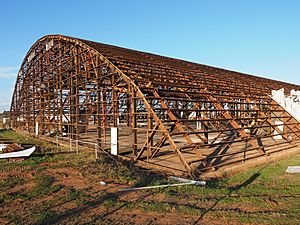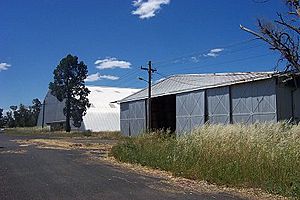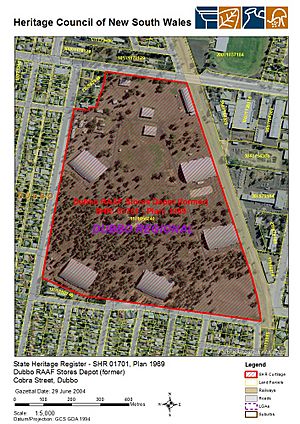Dubbo RAAF Stores Depot facts for kids
Quick facts for kids Dubbo RAAF Stores Depot |
|
|---|---|

Igloo building
|
|
| Location | Cobra Street, Dubbo, Dubbo Regional Council, New South Wales, Australia |
| Built | 1940–1943 |
| Architect | Sidney Williams & Co |
| Owner | Andorra Developments; Belmorgan Property Development |
| Official name: Dubbo RAAF Stores Depot (former); No. 5 (1942); No. 6 Stores Depot (1942-52); No. 2 Stores Depot Detachment D (1952-92); Defence National Storage and Distribution Centre Detachment (1992-1995) | |
| Type | State heritage (built) |
| Designated | 29 June 2004 |
| Reference no. | 1701 |
| Type | Military aircraft |
| Category | Defence |
| Lua error in Module:Location_map at line 420: attempt to index field 'wikibase' (a nil value). | |
The Dubbo RAAF Stores Depot is a special place in Dubbo, New South Wales, Australia. It used to be a big storage area for the Royal Australian Air Force (RAAF). This important site is located on Cobra Street. It was designed by Sidney Williams & Co and built between 1940 and 1943.
The depot has had a few different names over the years, like No. 5 Stores Depot and No. 6 Stores Depot. Today, private companies own the property. It was added to the New South Wales State Heritage Register on 29 June 2004 because of its historical importance.
Contents
A Look Back at Dubbo's History
Dubbo is located near the Macquarie River in New South Wales. Wiradjuri Aboriginal people have lived in this area for over 40,000 years. They had strong cultural traditions. Even after European settlers arrived, Aboriginal people kept many of their customs. Today, there's a large Aboriginal community in Dubbo, with many people still connected to their ancestors' lands.
On the former RAAF Stores Depot site, signs of Aboriginal history have been found. These include two scarred trees, where bark was removed long ago for tools or shelter. There's also an area where stone tools were found, which might have been an old camp site.
Early European Settlement
European explorers first came to the Dubbo region in the early 1800s. They saw that the land was good for farming and raising animals. By the 1830s, settlers started to claim land. In 1846, it was decided to build a courthouse and police station in Dubbo. This helped the town grow.
The railway line reached Dubbo in 1881, which brought more growth and new businesses. Dubbo became an important town, especially for moving animals and goods across the region.
The Site Before World War II
The land where the RAAF depot stands was set aside in 1874. It was known as "Bradfield Park" and was used for public recreation. Later, it became part of the Dubbo State Forest.
During the Great Depression in the 1930s, many families who didn't have homes camped on this land in makeshift tents. This included Aboriginal families. They called the area "Bagtown."
Dubbo's Role in World War II
When World War II started in 1939, Australia needed to quickly build more defence sites. The RAAF Stores Depot in Dubbo was one of these important places. It was chosen because it was far inland, away from the coast, which made it safer from enemy attacks.
The government bought the land in 1943. Dubbo was a good location because it was connected to major transport routes. The RAAF Stores Depot No. 6 was moved to Dubbo in December 1942. It was built at the same time as other RAAF facilities in Dubbo, like the aerodrome (airport).
The site was called "The Pines" because of the many cypress pine trees. These trees also helped to hide the military base from above. By April 1943, all 27 buildings at the depot were finished. They stored aeroplane parts, radio equipment, ammunition, and bombs. By 1945, hundreds of people worked at the RAAF sites in Dubbo. The Dubbo depot became the largest RAAF stores depot in Australia.
Clever Camouflage and Building Designs
The RAAF Stores Depot was planned very carefully. The roads were built to look like normal town streets to trick enemy planes. Gardens were even planted around buildings.
The large Igloo storage buildings were specially designed to look like hills from the air. They were painted to blend in, and their shapes were changed with metal sheets to look like trees. This was a very clever way to hide such big structures.
The depot also used many buildings that were made in parts and then put together on site. This was a fast way to build during the war. There were five types of these special buildings:
- Igloo stores: Huge, arched buildings.
- Bellman hangars: Large buildings for aircraft maintenance.
- Sidney Williams Hut: A type of workshop.
- Rabaul Store: Another steel-framed storage building.
- Inflammable Liquids Store: For storing flammable materials safely.
This site is special because it shows so many different types of these wartime prefabricated buildings.
After the War: A New Purpose
Most RAAF stores depots closed after World War II, but Dubbo's stayed open until the 1990s. It continued to store military supplies. The RAAF unit also helped the town during floods in 1955 and with bushfires.
In 1952, the site was transferred to the Army. RAAF involvement ended in 1956. The depot was used by the military until 1992. After that, it was used for all three defence forces (Army, Navy, Air Force) for a few years.
Civilian Uses and Community Life
After the military left, parts of the site were used for different things. Some areas were leased to local businesses and health services. For example, a part of the site was used as the headquarters for the East Coast Plague Locust Commission.
The former RAAF Stores Depot also played an important role in helping during natural disasters. It stored supplies for relief efforts after events like Cyclone Tracy in Darwin in 1974.
Many local groups used the buildings for storage or activities. For example, a new "State Coach" was built there for Queen Elizabeth II's visit in 1992. The site also hosted concerts, trade fairs, and rodeos. The band Silverchair even played a concert there in 1997!
Redevelopment Plans
The former depot site was sold to developers in 2011. Plans to build over 400 houses, along with tourism and hospitality businesses, were approved in 2018. The local council and heritage authorities gave their final approval in 2020.
What the Site Looks Like Today
The former RAAF Stores Depot covers about 38 hectares (94 acres) (about 94 acres). It's located southeast of Dubbo's city centre and is surrounded by houses. The buildings are spread out and connected by an internal road system. There are still areas with trees, especially cypress pines, which were part of the original forest.
The site is home to various animals, including bats and birds. The old Molong–Dubbo railway line runs along the eastern side. This railway allowed short tracks to be built right into the storage buildings, which helped with camouflage.
There are 30 buildings on the site, including:
- Five Igloo Stores buildings
- Three Bellman hangars
- A Rabaul Store
- A Sidney Williams Hut
- A large semi-underground PBX bunker (a communications centre)
- A former Inflammable Liquids store
- The Administration building
- The Pump House
The five Igloo Stores buildings are placed far apart to make them look like hills. This helped to hide them from the air.
Aboriginal History on Site
In 1999, experts talked with the local Aboriginal community. They found two scarred trees on the site. These trees show where Aboriginal people removed bark to make tools or containers. They also found stone tools, which might mean there was an old camp site there. These findings are protected by law.
Key Buildings Explained
Igloo Stores (Buildings 4, 5, 7, 8 and 11)
These five huge Igloo stores are amazing! They are 94.2 by 76.2 metres (309 ft × 250 ft) (about 309 x 250 feet) and show clever design. They used pre-made timber frames and trusses (support structures) adapted from American designs. They were built without roof lights to help with blackout rules during the war. They have arched roofs made of corrugated iron and concrete floors. Inside, they have cranes to move goods. The Igloo buildings were carefully placed and painted to look like hills from the air. They are some of the only examples of this type of building left in Australia.
Bellman Hangars
The three Bellman Hangars (one double, two single) show early ways of building things in parts. They were used for storing different items. These hangars had a pitched roof and steel frames, with sliding doors for easy access.
Underground PBX Bunker
This bunker is about 6 by 18 metres (20 ft × 59 ft) (20 x 59 feet) and was part of the communication centre for the region. It's a strong, arched concrete structure, partly buried underground. It was very important for wartime communication.
Rabaul Store (Building 1)
This building is made of steel and covered with corrugated iron. It's 84.1 by 18.3 metres (276 ft × 60 ft) (276 x 60 feet). The Rabaul Store was one of only two such buildings made in Australia. It's the only one of its kind still left on a defence property.
The Sidney Williams Hut
This corrugated iron shed or workshop is a special type of pre-made building called a Sidney Williams Hut. These were used a lot during World War II. They had a light steel frame and corrugated iron walls and roof. This is a good example of early prefabrication in Australia.
Other Buildings
There are also other buildings like storage sheds, toilets, a Motor Transport Garage, and a Pump House for firefighting. The Administration Building has a tiled roof, similar to other government buildings of that time. The Pump House, with its water tank, shows how important safety was for storing different materials.
Why Dubbo RAAF Stores Depot is Important
The former RAAF Stores Depot in Dubbo is a very important historical site. It's a large and well-preserved example of Australia's military bases during World War II. It shows how New South Wales helped in the war effort.
The site has thirty buildings, including the huge Igloo stores, Bellman hangars, and the Rabaul hangar. It also has its original road system and railway lines. It's rare to find five different types of 1940s pre-made buildings all in one place. The Igloo stores are still in great condition and are some of the only ones left in Australia. The Rabaul hangar is also unique.
The site is like a "cultural landscape" from the 1940s. The trees and the way the buildings are placed show how they were cleverly camouflaged to avoid air attacks. It's also important because it was the only World War II stores depot that stayed in military service until the 1990s. This shows its long connection to Australia's defence history.
The site also has heritage value because of its Aboriginal history, its past as a state forest, and its use as a camp during the Great Depression. It has also been used by the community for many different things.
The Dubbo RAAF Stores Depot was listed on the New South Wales State Heritage Register on 29 June 2004.
What Makes it Special?
- Historical Importance: It shows how Australia prepared for war and how military logistics worked. It's the largest and most complete example of its kind.
- Community Connection: Thousands of military and civilian people worked here. It's also important to the Dubbo community because of the RAAF's role in the town's life.
- Design and Technology: The site shows amazing building designs and techniques used during World War II. The way the trees were kept to camouflage the site is also special. The Igloo stores and other pre-made buildings show how new building methods were used.
- Social and Cultural Value: The site is important to the Aboriginal community in Dubbo. Many Aboriginal people lived here before it became a military base. Older community members have fond memories and stories about "the Pines."
- Research Potential: The site can teach us more about Dubbo's role in national transport and the region's economy during the war. The Aboriginal findings also offer chances for more research.
- Rarity: The five Igloo buildings are very rare, and the Rabaul Store is unique. The whole complex is one of the most complete examples of a wartime RAAF logistics base left in Australia.
- Typical Characteristics: It shows what military stores depots were like during World War II, including their layout, camouflage, and building styles. The Bellman hangars and Sidney Williams Hut are good examples of common wartime structures.
Condition of the Site
As of 2003, this complex of military buildings was the only one of its kind in Australia that was still mostly intact and in its original layout. The buildings are in excellent condition, partly because of the dry climate and good maintenance.




